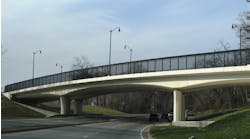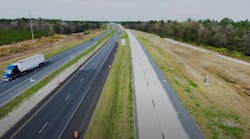The 23-mile Long Beach Freeway (I-710) runs from the city of Alhambra, Calif., near Pasadena, to the Long Beach Harbor.
Along with some 230,000 vehicles a day in some spots, it carries the majority of goods coming into and out of the ports of Los Angeles and Long Beach on the largest concentration of trucks in Los Angeles County.
Trucks account for nearly 20% of the traffic, which is roughly four times the amount envisioned when the freeway was built. No wonder its pavement was stressed out. The majority of the current freeway, built in sections between the early 1950s and mid-1970s, was more than ready for a stint in rehab. The California Department of Transportation (Caltrans) began a pavement overhaul project on I-710 in 2001, beginning with a 2.5-mile section in Long Beach. Known as the Long Life Pavement Rehabilitation project, the work has moved up the freeway in stages, of which the current project is No. 5. So far, 18 miles of freeway in both directions have been reconstructed.
The project marked the first use on a California freeway of a new, highly engineered, more durable and more flexible asphalt mix, jointly developed by Caltrans, the asphalt industry and pavement scientists.
Now the I-710 paving project will be the site of another innovation in pavement rehabilitation: the largest use of precast/prestressed concrete panels (PPCP) on any road renovation in the U.S. The 9.2-mile job calls for more than 4,100 panels to be placed in the Nos. 3 and 4 lanes. The Nos. 1 and 2 lanes will be resurfaced via slab replacement.
Ever since Caltrans District Materials Engineer Kirsten Stahl first heard about the process from a member of the Precast Manufacturers Association of California back in 2000, she has been looking for opportunities to employ the product on a large-scale project following successful application in various emergency repair jobs.
The benefits are clear: Precast panels install quickly in any weather with no special materials needed and they can be driven on immediately, said Stahl. On a high-volume route like I-710, that is a critical factor, because closing the road for any length of time would impact not only motorists but also goods movement.
A slight increase
Precast concrete has been in use in building bridges for decades—now its time in roadway reconstruction apparently has come. The I-710 project involves 36 lane-miles of concrete panels, equivalent to 831,000 sq ft or 27,700 cu yd. Among the application’s various challenges is the fact that, because of the roadway’s geography, the panels taper in width from 26 ft on one end to 36 ft on the other. “Each panel has to get slightly larger so each one is different,” Stahl said.
And each panel requires a shop drawing, and each drawing has to be approved by Caltrans. Four design engineers have been assigned to work exclusively on reviewing the panels with the expectation that they each will be able to review five a day, or 60 per week. Once 60 drawings are approved, the fabricator, Mid-State Precast of Corcoran, Calif., will begin production.
Set upon fully engineered subgrade surfaces, the panels are interlocking through post-tensioning and set by grouting. This system allows for continuous and intermittent replacement of the previously existing pavement.
“Combining shorter construction duration with the longevity of precast concrete allows for the highway replacement to be cost-effective for Caltrans and the taxpayers of California,” said Mid-State Project Engineer Safwat Ibrahim. Precast work is expected to be completed in September 2014.
The fabrication process basically involves the following components:
- Assembling the form;
- Pouring the concrete into the forms;
- Testing the concrete to determine if panels can be released from the forms;
- Dismantling the form; and
- Curing the concrete for two weeks.
Initial installation could begin before the end of the year. At that time, Caltrans will initiate a series of 36 full freeway weekend closures in which the freeway is closed in one direction at a time, shifting two-way traffic onto the open side. This traffic-control method has been used in every segment of the I-710 freeway pavement-rehabilitation project to date, however 36 closures are roughly three times as many as each other segment required.
“Based on the success of the traffic staging on the other I-710 pavement-rehabilitation projects, we are confident that we will be able to implement these closures with a moderate level of impact to motorists,” said Caltrans Resident Engineer Reza Jahromi.
Shimmick/Myers and Sons, JV, is the contractor. “We selected this project because of the precast element,” said Micaiah Revero, project manager. “We like to go after work that has some unique value and we saw a competitive advantage here.”
Although Shimmick/Myers and Sons has not had any prior precast projects, individuals within the company have that experience, Revero said. Also, there are some similarities to performing rapid-set concrete installation, he added, including lane closures, preparing for roadway subgrading and interaction between multiple suppliers and subcontractors. “We do anticipate enormous coordination efforts, but we’re confident we can overcome those challenges.”
But all that lies ahead. For now, the contractor is busy with such work as removals, excavation, bridge demolition, utility relocation, constructing sound walls and retaining walls, drainage, etc. And they are not “pre-stressing” about the complex pavement operation to come.
Leveling on
While it prepares for the precast panel work on I-710, Caltrans is continuing to develop its skills on other freeways. In March of this year, several of the department’s maintenance workers participated in a demonstration emergency slab repair project on the Foothill Freeway (I-210) in the La Canada Flintridge area.
Stahl has been advocating for the use of precast panels in repair work as well.
“This is a natural application,” she said. “If we have these panels stored at a maintenance yard nearby, we can drop them in and open to traffic an hour later.”
Precast-panel repairs initially are more expensive than cast-in-place, but they’re also more durable, which means they’re cheaper in the long run and require fewer maintenance closures. The tricky part of working with precast panels is the installation. Grinding and leveling the panels can be difficult and time-consuming. But that’s changing as the department gains more experience.
The key to the increased competence is a piece of hardware called (for lack of a better term) a leveling lift, developed by a Caltrans maintenance supervisor. The leveling lift allows panels to be installed quickly and relatively easily without extensive grinding. Essentially, it allows the panel to be raised up and down using a screw-like mechanism.
Crews installing panels without a leveling lift can typically complete 124 ft of repairs in a night. With the leveling lift, they can do 500 ft. With the strategy working so well, Caltrans invited contractors and staff to observe and participate in an installation.
Essentially, the procedure is as follows:
Step 1: Mark and measure the precast panel layout. Cut the damaged slab into chunks, which will then be lifted out of the roadbed, similar to removing big, concrete brownies from a pan.
Step 2: Grind the roadbed so it’s a bit deeper than the thickness of the panel, which in this case, was 8.5 in. Clean up debris.
Step 3: Lay thick plastic sheeting in the cavity to keep the grout from oozing into places where grout shouldn’t ooze.
Step 4: Using a crane, place the concrete panel in the excavation. The panels and excavation can be trimmed to fit before placing them, if necessary.
Step 5: Level the panel so it’s even with neighboring slabs by adjusting the leveling screws in the corners. This is sort of like leveling a tripod by adjusting the height of the legs.
Step 6: Pump rapid-setting, self-leveling grout under the panel and open to traffic. The dowel bars that fit into the dowel joints connecting the panels can be installed up to 48 hours later, if necessary.
The steps listed above are, of course, an oversimplification, but installing concrete panels using this method is considerably simpler than the standard method. Since the excavation can be cut to fit the panel, level the panel with screws and grout it to achieve the necessary depth, which obviates the need for surveys. The lane can be closed, the panel installed and the road reopened to traffic within three hours.
Not only do the panels install quickly and thereby minimize closures and exposure of crews to live traffic, they also can be removed and reused somewhere else. Additionally, they can be installed in any weather and they last a long time, an estimated 50 years according to Caltrans maintenance folks.
After the demo on I-210, a second demo was performed a week later, followed by installation of another 28 panels on the northbound San Diego Freeway (I-405) near Los Angeles International Airport.
Panels continue to be placed using the leveling lift system while Caltrans perfects the process. Leveling-lift installation is not yet widely used by the department, but if the panels that have been installed so far hold up well, it could be. There are now hundreds of panels on Los Angeles-area freeways testifying to their versatility and to the ingenuity of Caltrans workers.
With a combination of the right product at the right time and a skilled, clever work force recognizing its value and expanding its applications, this could become the infrastructure fix of the future. R&B



